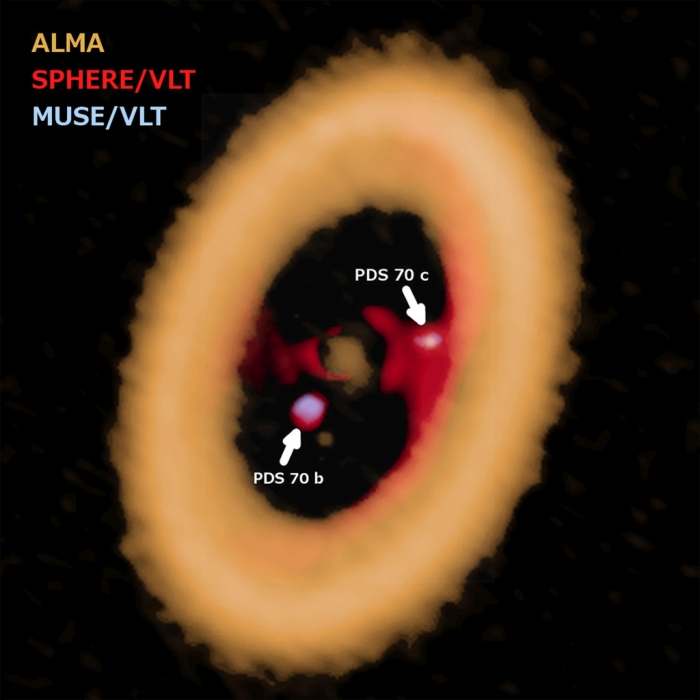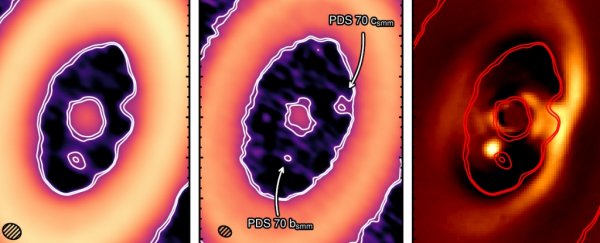Once upon a time, the great planet Jupiter was orbited by a glorious ring of dust, according to astronomers. Now, nothing of it remains, having coalesced long ago into the planet's Galilean moons.
But these moon-forming discs should be found around other planets in alien star systems. And for the first time we have confirmation of this, because astronomers have found one, and they have the images to prove it.
The planet in question is PDS 70 c, one of two Jupiter-sized gas giants orbiting a young, low-mass star roughly 370 light-years from Earth. Astronomers used the Atacama Large Millimeter/submillimeter Array (ALMA) to detect the radio waves emitted by microscopic specks of dust encircling the entire system.
These observations revealed a concentration of dust around the still-forming planet, orbiting the star at a distance of around 5.31 billion kilometres (3.3 billion miles).
Astronomers believe this is no other than a circumplanetary disc; just as protoplanetary discs around young stars eventually coalesce into planets, it seems likely that this disc is going to eventually clump together into moons.
"For the first time, we can conclusively see the telltale signs of a circumplanetary disc, which helps to support many of the current theories of planet formation," said astronomer Andrea Isella of Rice University.
"By comparing our observations to the high-resolution infrared and optical images, we can clearly see that an otherwise enigmatic concentration of tiny dust particles is actually a planet-girding disk of dust, the first such feature ever conclusively observed."
Rings such as these are very different from the rings of Saturn, which are only estimated to be about 100 million years old, compared to the 4.5 billion-year age of the Solar System. Saturn's rings are made of ice and dust and rocks, and are thought to be the debris from comets, asteroids and maybe even moons that somehow broke apart around the planet.
The ring around PDS 70 c, on the other hand, is around at a much earlier age. The star is just 10 million years old, the planets barely formed.
After their cores are formed, the process of accretion is thought to be very similar in stars and planets, material swirling around them in a disc and falling onto the object, increasing its mass. In the case of a star, the material that's leftover from this process ends up forming planets.
So, it's thought that the disc around PDS 70 c is from this accretion process; indeed, the brightness of the object in infrared and hydrogen bands indicates that not only is there a planet in the dust clump, but that it's going through a growth spurt, actively accreting from that glowing disc.
 (ALMA (ESO/NAOJ/NRAO) A. Isella; ESO)
(ALMA (ESO/NAOJ/NRAO) A. Isella; ESO)
But, we mentioned that it was one of two planets. The other, orbiting closer to the star at around 3.22 billion kilometres, is PDS 70 b. The astronomers aren't entirely sure, because the signal is so faint, but they think it, too, might have a ring around it, albeit a fainter one.
In addition, there is a strange smear of dust not far from PDS 70 b, a trailing mass like the tail of a comet.
"What this is and what it means for this planetary system is not yet known. The only conclusive thing we can say is that it is far enough from the planet to be an independent feature," Isella noted.
It's a mysterious system, and it may have a lot to teach us. It's unlikely to show us our first exomoons - that dust probably won't form solid chunks for many human lifetimes, and it would be nice to think we're closer to exomoons than that - but its value to understanding the planetary formation process got bumped up a few notches with the discovery of the first circumplanetary disc.
And ALMA's ability to image objects in the dust around stars means astronomers will be able to take more observations in the future, mapping the positions of the planets and changes in the dust, to observe these processes in action.
The research has been published in The Astrophysical Journal Letters.
